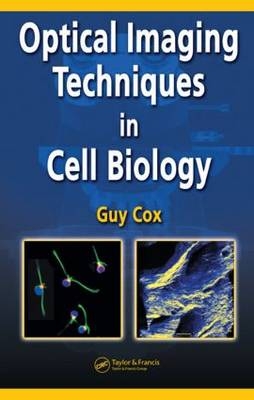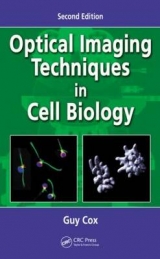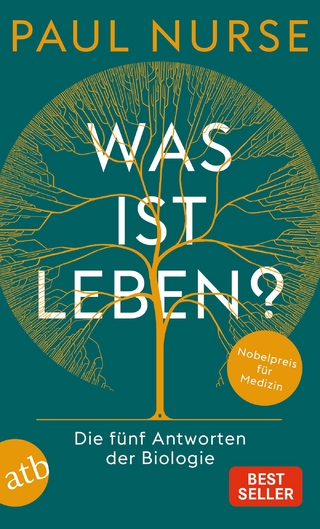
Optical Imaging Techniques in Cell Biology
Crc Press Inc (Verlag)
978-0-8493-3919-6 (ISBN)
- Titel erscheint in neuer Auflage
- Artikel merken
Since the word microscopy was coined in 1656, the evolution of the instrument has had a long and convoluted history. Plagued with problems of chromatic aberration, spherical aberration, and challenges with illumination and resolution, the microscope’s technical progression happened in a series of fits and starts until the late 19th century. After Ernst Abbe perfected the “how” of lens design, achieving the theoretical limit imposed by wavelength, there came a revolution in subject matter or “what” could be studied by microscope.
Covering the entire field of microscopy, Optical Imaging Techniques in Cell Biology provides an overview of the technical evolution of the microscope and explains how the basics of optical microscopy led to the most advanced techniques employed today. The author addresses a vast array of topics including optical contrasting techniques, fluorescence, confocal versus widefield microscopes, lasers as a light source, and digital imaging, as well as the correction of aberrations that might arise. Building on this foundation, he then examines more advanced techniques such as quantitative fluorescence, fluorescence resonant energy, three-dimensional imaging, high-speed confocal microscopy, non-linear microscopy, and stimulated emission depletion.
Delivering a truly comprehensive work encompassing the scope and breadth of the field, the author brings a new level of understanding to the student, technician, researcher, or investigator working in the fascinating realm of optical microscopy.
Introduction: – The Optical Microscope In Cell Biology
Brief historical overview from Robert Hooke (cells, 1685) through Swammerdam, van Leeuwenhoek (sperm, bacteria, blood cells), Robert Browne (nucleus), Schwann & Schleiden (cell theory), Lister (corrected objectives), Abbe, etc.
The Light Microscope
Lenses and Microscopes
The Back Focal Plane of a Lens
Good Resolution
Resolution: Rayleigh’s approach
Diffraction: Abbe’s approach
Add a Drop of Oil …
Köhler Illumination
Optical Contrasting Techniques
Darkfield
Phase Contrast
Polarization
Differential Interference Contrast
Which Technique Is Best?
Fluorescence and Fluorescence Microscopy
What Is Fluorescence?
What Makes a Molecule Fluorescent?
The Fluorescence Microscope
Optical Arrangement
Light Source
Filter Sets
Image Capture
Optical Layout for Image Capture
Film
Monochrome
Color Films
Additive Color Model
Subtractive Color Model
CCD Cameras
Frame-Transfer Array
Interline-Transfer Array
Back Illumination
Binning
Recording Color
Filter Wheels
Filter Mosaics
Three CCD Elements with Dichroic Beamsplitters
The Confocal Microscope
The Scanning Optical Microscope
The Confocal Principle
Resolution and Point Spread Function
Lateral Resolution in the Confocal Microscope
Practical Confocal Microscopes
The Light Source: Lasers
Gas Lasers
Solid-State Lasers
Semiconductor Lasers
Laser Delivery
The Primary Beamsplitter
Beam Scanning
Pinhole and Signal Channel Configurations
Detectors
The Digital Image
Pixels and Voxels
Contrast
Spatial Sampling: The Nyquist Criterion
Temporal Sampling: Signal-to-Noise Ratio
Multichannel Images
Aberrations and Their Consequences
Geometrical Aberrations
Spherical Aberration (SA)
Coma
Astigmatism
Field Curvature
Chromatic Aberration
Chromatic Difference of Magnification
Practical Consequences
Apparent Depth
Nonlinear Microscopy
Multiphoton Microscopy
Principles of Two-Photon Fluorescence
Theory and Practice
Lasers for Nonlinear Microscopy
Advantages of Two-Photon Excitation
Construction of a Multiphoton Microscope
Fluorochromes for Multiphoton Microscopy
Second Harmonic Microscopy
High-Speed Confocal Microscopy
Tandem-Scanning (Spinning Disk) Microscopes
Petràn System
One-Sided Nipkow Disk Microscopes (OTSMs)
Microlens Array: The Yokogawa System
Slit-Scanning Microscopes
Slit–Slit Systems
Spot–Slit Systems
Multipoint-Array Scanners
Structured Illumination
Deconvolution and Image Processing
Deconvolution
Deconvolving Confocal Images
Image Processing
Gray-Scale Operations
Image Arithmetic
Convolution: Smoothing and Sharpening
Three-Dimensional Imaging: Stereoscopy and Reconstruction
Surfaces: Two-and-a-Half Dimensions
Perception of the 3D World
Limitations of Confocal Microscopy
Stereoscopy
Three-Dimensional Reconstruction
Techniques that Require Identification of "Objects"
Techniques that Create Views Directly from Intensity Data
Simple projections
Weighted projection (alpha blending)
Green Fluorescent Protein
Structure and Properties of GFP
GFP Variants
Applications of GFP
Heat Shock
Cationic Lipid Reagents
DEAE–Dextran and Polybrene
Calcium Phosphate Coprecipitation
Electroporation
Microinjection
Gene Gun
Plants: Agrobacterium
Fluorescent Staining
Immunolabeling
Types of Antibody
Raising Antibodies
Labeling
Fluorescent Stains for Cell Components and Compartments
Quantitative Fluorescence
Fluorescence Intensity Measurements
Linearity Calibration
Measurement
Colocalization
Ratio Imaging
Cell Loading
Membrane Potential
Slow-Response Dyes
Fluorescence Recovery after Photobleaching
Advanced Fluorescence Techniques: FLIM and FRET
Fluorescence Lifetime
Practical Lifetime Microscopy
Frequency Domain
Time Domain
Fluorescence Resonant Energy Transfer (FRET)
Why Use FRET?
Identifying and Quantifying FRET
Increase in brightness of acceptor emission
Quenching of emission from the donor
Lifetime of donor emission
Protection from bleaching of donor
Fluorescence Correlation Spectroscopy (FCS)
Breaking the Diffraction Limit
Near-Field Microscopy
Total Internal Reflection Microscopy (TIRF)
4-p and Multiple-Objective Microscopy
Stimulated Emission Depletion (STED)
Appendix 1
Microscope Care and Maintenance
Cleaning
The Fluorescent Illuminator
Appendix 2
Keeping Cells Alive under the Microscope
Chambers
Light
Movement
Finally
Appendix 3
Antibody Labeling of Plant and Animal Cells: Tips and
Sample Schedules
Antibodies: Tips on Handling and Storage
Pipettes: Tips on Handling
Antibodies and Antibody Titrations
Example
Primary antibody titration
Immunofluorescence Protocol
Method
Multiple Labeling and Different Samples
Plant Material
Protocol
Diagram showing position of antibodies on multiwell slide:
Appendix 4
Image Processing with ImageJ
Introduction
Different Windows in ImageJ
Image Levels
Colors and Look-up Tables
Size Calibration
Image Math
Quantification
Stacks and 3D Representation
FFT and Image Processing
Macro Language in ImageJ
| Erscheint lt. Verlag | 6.11.2006 |
|---|---|
| Zusatzinfo | 224 Halftones, black and white; 6 Tables, black and white; 15 Illustrations, color; 220 Illustrations, black and white |
| Verlagsort | Bosa Roca |
| Sprache | englisch |
| Maße | 156 x 234 mm |
| Gewicht | 635 g |
| Themenwelt | Naturwissenschaften ► Biologie ► Zellbiologie |
| ISBN-10 | 0-8493-3919-7 / 0849339197 |
| ISBN-13 | 978-0-8493-3919-6 / 9780849339196 |
| Zustand | Neuware |
| Informationen gemäß Produktsicherheitsverordnung (GPSR) | |
| Haben Sie eine Frage zum Produkt? |
aus dem Bereich

